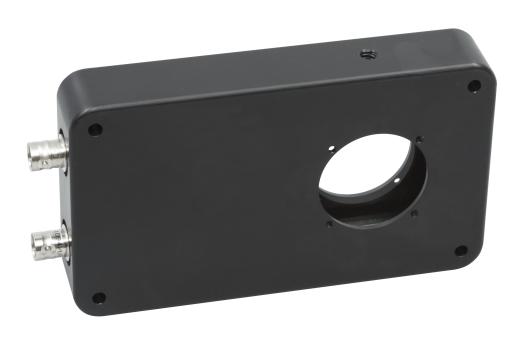
Photoelastic Modulators (PEMs)
Supplier: Hinds Instruments

Technology type: Photoelastic Modulators
Photoelastic modulators (PEMs) are key components in a diverse range of photonics applications. Hinds Instruments are the world leader based on the principles of polarisation modulation. Measuring the polarisation of light is enabled thanks to a wide range of photoelastic modulators developed for a variety of applications across a wide spectral region, UV to TeraHertz.
Hinds Instruments PEMs are made of isotropic optical materials and operate at a resonant frequency and are used across a variety of applications including chopping a light beam (20 - 84kHz), birefringence measurements, stokes polarimetry, optical rotation polarimetry, linear and circular dichroism in UV-Vis and IR, magnetic circular dichroism, FTIR double modulation spectroscopy (VCD, VLD, IRRAS), ellipsometry, fluorescence polarisation, and waveplate measurement.
Range features
A high level overview of what this range offers
- Wide range of products for different spectral regions, from vacuum UV to Terahertz
- Aperture: up to 56mm
- Nominal Frequency: several values available between 20kHz and 84kHz
- Large acceptance angle
- Polarisation purity and high-power handling capability - up to 5 GW/cm2 for some devices
- Retardation: quarter-wave or half-wave
- Assemblies: one PEM or dual PEM
- Delay stability, renowned for stable, trouble-free performance
- Options: anti-reflective coating, magnetic field compatible, vacuum compatible
- Durability – (some PEMs are still in use from 1977)
What's in this range?
All the variants in the range and a comparison of what they offer
|
Model |
Nominal frequency |
Quarter wave retardation range |
Half-wave retardation range |
Useful aperture |
|---|---|---|---|---|
|
I/FS50 |
50kHz |
170nm – 2µm |
170nm – 1µm |
16mm |
|
I/FS20 |
20kHz |
170nm – 2µm |
170nm – 1µm |
22mm |
|
I/CF50 |
50kHz |
130nm – 1µm |
130nm – 500nm |
16mm |
|
II/FS20 |
20kHz |
170nm – 2.6µm |
170nm – 2.5µm |
56mm |
|
II/FS42 |
42kHz |
170nm – 2.6µm |
170nm – 2.5µm |
27mm |
|
II/FS47 |
47kHz |
170nm – 2.6µm |
170nm – 2.5µm |
24mm |
|
II/FS50 |
50kHz |
170nm – 2.6µm |
170nm – 2.5µm |
22mm |
|
II/FS84 |
84kHz |
200nm – 2.5µm |
200nm – 2.5µm |
13mm |
|
II/IS42 |
42kHz |
300nm – 3.5µm |
300nm – 3µm |
27mm |
|
II/IS84 |
84kHz |
300nm – 3.5µm |
300nm – 3µm |
13mm |
|
II/CF57 |
57kHz |
2µm – 8.5µm |
2µm – 5.5µm |
23mm |
|
II/ZS37 |
37kHz |
2µm – 18µm |
1µm – 9µm |
19mm |
|
II/ZS42 |
42kHz |
2µm – 18µm |
1µm – 10µm |
17mm |
|
II/ZS50 |
50kHz |
2µm – 18µm |
1µm – 10µm |
14mm |
|
II/SI40 |
40kHz |
28µm – 57µm |
– |
36mm |
|
II/SI50 |
50kHz |
28µm – 57µm |
– |
29mm |
Frequently asked questions
What is a Photoelastic Modulator (PEM) and how does it work? 👇
A Photoelastic Modulator (PEM) is an optical device that modulates the polarisation of light to gain information about mechanical stresses in materials. This is achieved by using photoelastic material that changes its optical properties due to mechanical stress. The PEM by Hinds Instruments utilises this effect to provide precise information about the stress distribution in an examined object.
How does the optical head of my PEM work? 👇
The basic operating principle of the PEM is based on the photoelastic effect. A mechanically stressed sample exhibits birefringence proportional to the strain caused by the induced stress. Therefore, the PEM can be considered a birefringence modulator. The optics' resonance results in birefringence along an axis that is either compressed or stretched, causing the light to travel faster or slower along this axis. For instance, in quartz glass, the light moves faster along the horizontal component when compressed and slower along the horizontal axis (parallel to the modulation) when stretched.
What advantages does PEM offer compared to other types of polarisation modulation? 👇
PEMs have several unique features, including a broad spectral range, large aperture, wide acceptance angle, and precise phase modulation. They are typically used for fast and highly sensitive measurements. Unlike Pockels cells and electro-optical modulators, optical elements made of quartz glass are isotropic when no stress is applied. This gives the PEM an expanded acceptance angle.
In which spectral range do PEMs manufactured by Hinds operate? 👇
Hinds produces over a dozen standard PEM models that collectively cover the range from 130 nm to 57 µm.
What does the integration of the Photoelastic Modulator into existing measurement systems look like? 👇
Integrating Hinds Instruments' PEM into existing measurement systems is generally straightforward. The modulator can be incorporated into optical setups and works well with common light sources and detectors. Hinds Instruments often provides software and interfaces that facilitate seamless integration into various measurement systems. This ensures easy adaptation to the specific requirements of the users.
Downloads

Enquire
Submit your enquiry directly to one of our Technical Sales Specialists.
Alternatively call our Sales Team.
Mandatory fields*
 Italy
Italy




